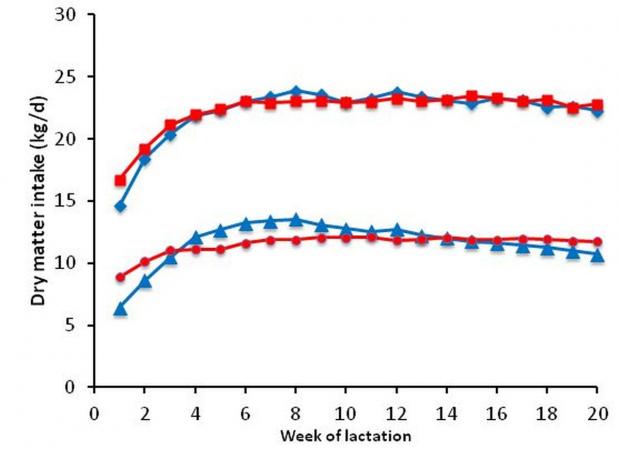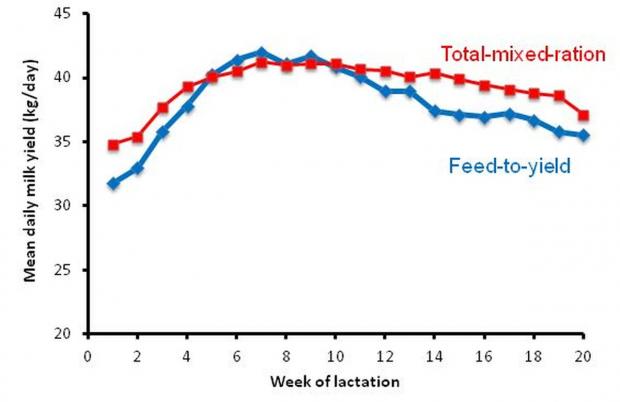Genetic selection for milk production in dairy cows over the last few decades has resulted in higher milk yields. As a result, within days of calving it is common for dairy cows to produce ten times more milk than the calf needs.

However, increasing milk yields have not been mirrored by a corresponding increase in intake potential, especially in early lactation. In fact, peak intake lags behind peak milk production by two to three weeks, and when cows are unable to consume enough energy to meet their requirements, they enter a period of negative energy balance. This places cows in a ‘break-down’ mode whereby their energy supply comes from fat stores – commonly termed milking ‘off her back.’ Negative energy balance is known to have a detrimental effect on fertility. In addition, there is evidence that cows that experience excessive negative energy are more likely to have a lower immune status (immune suppression), so it is unsurprising that 75% of production diseases occur during early lactation.

Research programme
This study was conducted at AFBI-Hillsborough and involved 72 Holstein-Friesian dairy cows with an average PLI of £119 (top 1% of UK genetics). Cows remained on the study from calving until 140 days after calving. All cows were offered a diet comprising first cut grass silage and a concentrate supplement, with the concentrate offered using two different allocation strategies, as follows:
Total-mixed-ration: with this treatment, the grass silage and concentrates (50% silage : 50% concentrate, on a dry matter basis) were mixed using a complete diet mixer wagon.
Feed-to-yield: with this treatment, the grass silage and concentrates were offered separately. Concentrates were offered ‘Feed-to-yield’, with the grass silage calculated to sustain an average milk yield of 24 kg per cow per day, and with concentrates then offered to sustain milk yields above this level of performance (at a feed rate of 0.45 kg concentrate per kg of milk).
Outcomes
In order to allow the two treatments to be compared, it was critical that the total concentrate intakes were as similar as possible in both treatments. This was achieved, with average total concentrate intakes over the 140 day study period being 1635 kg with the Total-mixed-ration treatment and 1616 kg with the Feed-to-yield treatment. Nevertheless, the pattern of concentrate allocation was very different between the two treatments, as highlighted in Figure 1. While cows on the Total-mixed-ration treatment had a relatively ‘flat’ concentrate intake line, the concentrate intake line for cows on the Feed-to-yield treatment, followed the shape of the lactation curve, as expected. Total DM intake was very similar for each group throughout the study and averaged 22kg DM per day.

Cows on Feed-to-yield lost more live-weight than those on the Total-mixed-ration, although there was no difference in body condition score loss between the two groups of cows. There were, however, a greater number of cows with ‘stomach problems,’ (right and left displaced abomasum and dilated caecum) under the Feed-to-yield strategy. This was likely due to the large quantity of concentrates that were offered to some cows on this treatment, though none of the other health parameters measured were affected by concentrate allocation strategy. Fertility performance was improved with the Feed-to-yield treatment, with cows having an increased conception rate to first and second service and a higher 100-day in-calf rate. The reasons for this are unclear and further research is in progress to investigate this, which include detailed examination of twice-weekly milk progesterone analysis.
Practical implications
This study demonstrates that similar levels of milk production can be achieved with a simple ‘group’ feeding system involving a total-mixed-ration, as with a more complex system involving allocating concentrates to individual cows. However, it is important to note that this study involved a group of cows with a tight calving pattern (October to December calving), and consequently all cows were at a relatively similar stage of lactation throughout the study period. In contrast, herds on most farms have a much wider spread in calving pattern, with freshly calved cows frequently mixed with cows in mid and late lactation. In this scenario, offering a single Total-mixed-ration would result in late lactation cows being over-fed, and concentrates being used inefficiently. When a Total-mixed-ration is offered to herds with a more widely spread calving pattern, cows need to be grouped according to milk yield to avoid either overfeeding or underfeeding. The adoption of a ‘Feed-to-yield’ approach would clearly overcome this problem. Nevertheless, irrespective which strategy is adopted, it is essential that the level of concentrate feeding is appropriate for the quality of the silage on offer, and the milk yield potential of the cows in the herd. Overfeeding concentrates at current milk prices is something that no farmer can afford to do. The fertility gains observed in this study with a feed to yield approach are also a potentially important benefit of a feeding regime tailored to cow requirements, but further investigation is needed to validate both the repeatability and magnitude of the responses recorded in the current study.
Notes to editors:
AFBI carries out high quality technology research and development, statutory, analytical, and diagnostic testing functions for DARD and other Government departments, public bodies and commercial companies.
AFBI's Vision is “Scientific excellence in Northern Ireland … serving the world”.
All media enquiries to AFBI Press Office
Latest news
- AFBI issues Nematodirus warning – Spring 2025 11 April 2025
- Managing Nature Based Risks to the UK Economy and Opportunities for Green Finance 08 April 2025
- AFBI Hillsborough host AERA committee 27 March 2025
- The Omics Days Conference 27 March 2025
